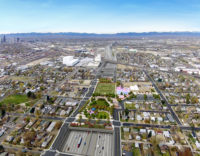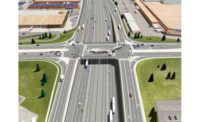Colorado motorists have spent a long time waiting—much of it behind the wheel—for congestion to ease along a stretch of I-70 extending from Denver into mountain resort towns.
The wait times, typically at their worst on summer and winter weekends, will soon be over. The Colorado Dept. of Transportation (CDOT) is building a tolled, peak-period inner shoulder lane (PPSL) along the rocky 12-mile corridor that extends west from Veterans Memorial Tunnels in Idaho Springs to Empire Junction.
Construction of the $70-million lane began in July 2019 and is due for completion in February, says Ray Strandberg, Colorado-North construction, engineering and inspection leader with RS&H, the project’s Greenwood Village, Colo-based owner’s representative.
In some respects, the project represents round two for CDOT; HDR Engineering Inc., the engineer of record; and RS&H. Those firms participated in the completion of an eastbound PPSL along the same I-70 corridor in 2015. The eastbound lanes proved particularly nettlesome, in part because many motorists depart the mountain resorts simultaneously on Sunday afternoons to make the trip back to Denver.
Conditions have improved considerably with the new eastbound inner lane, which captures up to 8.2% of peak-period traffic throughout the winter (about 152,000 vehicles) and 10.5% of summer traffic, roughly 105,000 vehicles during that period, resulting in average corridor speeds of 45 mph, according to the High Performance Transportation Enterprise (HPTE), an independent government-owned business unit within CDOT.
A Downhill Slog
Westbound weekend traffic initially was more diffuse, though increasing congestion—partly the result of the state’s rapid population growth—brought peak-period traffic to a standstill, says Jeff Hampton, project engineer with CDOT. “Virtually all traffic flows through the corridor to either reach or return from Colorado’s central mountains,” Hampton says. “There aren’t many alternative routes between the Denver metro area and the mountains.”
Like its predecessor, the westbound PPSL only will operate during peak periods—in this case, select hours on Friday, Saturday and Sunday—as compared with parts of Saturday and Sunday for eastbound traffic. All told, usage of the westbound PPSL will be limited to 125 days per year, just as usage of the eastbound PPSL is limited to 100 days per year. On other days, the PPSL will revert to a standard shoulder lane, like its eastbound counterpart.
“This is definitely a round-the- clock project.”
– Ned Meyers, Senior Project Manager, Graham Contracting
Another formidable constraint called for squeezing as much space as possible from existing infrastructure to accommodate the 11-ft-wide PPSL.
“The goal was to minimize widening I-70 by maximizing the existing footprint,” says Neil Ogden, resident engineer with CDOT. The original footprint consisted of a pair of 12-ft-wide lanes, a 4-ft-wide inner way and an outer shoulder of varying widths, up to 10 ft, potentially bringing the total width to 38 ft. To construct the 11-ft-wide PPSL, CDOT required an overall width of 42 ft, including a 4-ft-wide outer shoulder and 2 ft of inner shy distance between the PPSL and the inner barrier.
Space and usage constraints were imposed because both eastbound and westbound PPSLs are classified as interim solutions for congestion. They are intended to cease operations by 2035, when alternative solutions to congestion in the corridor may be ready for implementation. As such, activities included programs and reviews to minimize the impact of the PPSLs on the environment, including a CDOT-mandated context sensitive solutions process (CSSP), performed in accordance with federal guidelines. It also included input from multi-disciplined, multi-interest stakeholders.
Provisions also called for measures to mitigate noise, light and air pollution during construction. Air-quality measures, for instance, required that vehicles and equipment employ the cleanest possible fuels and that project team members devise a fugitive dust-control program, according to Vanessa Henderson, I-70 Mountain Corridor environmental manager with CDOT.
Tight Fit
To accommodate the PPSL, planners allocated up to 6 ft from the outside shoulder in areas where the footage existed and 2 ft from the inner way, says Chau Nguyen, senior transportation project manager with HDR. Additional space came from new pavement placed beyond the outer shoulder in locations that did not abut rock formations. Alternatively, plans extracted some space from a grassy median between the westbound and eastbound lanes, Nguyen adds.
Nevertheless, about 65% of the space for new pavement comes from the median area and about 35% from outside the shoulder, estimates Ned Meyers, senior project manager with Graham Contracting, Westminster, Colo., the project’s general contractor.
As work proceeds, the CSSP mandates that existing lanes remain open during the day, with partial closures limited to overnight hours. As paving vacillates from one side of 1-70 to the other, existing lane locations temporarily shift, requiring that crews realign the lanes with concrete barriers during night shifts to accommodate work zones, Meyers says. “This is definitely a round-the-clock project,” he says.
Methods and materials to construct new pavement have varied, depending on location. Installation of new pavement adjoining the outside shoulder required excavating down to subgrade—about 15 in. to 16 in. deep—followed by adding 6 in. of backfill, or base course, to the excavated space. The infill consists of a semipermeable aggregate of gravel and finer granules that promote moisture migration to subgrades, says Hampton. To achieve the final elevation of roadway, crews next paved three lifts of hot-mix asphalt totaling 9.5 in., Strandberg notes.
Ongoing work within the median has proved more complex. In some locations, the grassy strip sloped downward between the westbound and eastbound lanes, creating grade variations of up to 8 ft between the two. As a result, construction of retaining walls and supporting mechanically stabilized earth—or backfill—was required to create a platform for additional pavement within the median, according to Hampton. All told, the walls consist of 10-ft-wide, 6-in.-thick precast concrete panels that vary in height from 3 ft to 8 ft, depending on grade differentials.
Crews first excavated several inches to construct cast-in-place leveling pads for the panels, then hoisted panels into place via cable supplied to the excavator, Strandberg says. Temporary bracing supported the panels while workers constructed adjoining backfill consisting of “89” stone that is compacted but also porous enough for drainage, Strandberg adds. Crews employed skid steers to place the stone and smooth drum rollers to optimize compaction.
A series of metal straps at various intervals on the back of each precast panel are anchored into the backfill to join the two. Crews then topped the assembly with a 12-in.-thick reinforced concrete anchor slab to support a Type 7 concrete barrier that extends the length of the entire wall. Three inches of asphalt then will be placed upon the anchor slab to serve as pavement. Additional pavement comes from asphalt applications to a gap sited between the slab and existing roadway.
In all, about four miles of retaining walls are required, Hampton says.
Seasonal Work
Asphalt applications require temperatures greater than 50° F, so initial installation coincided with the summer months of 2019. Work proceeded from west to east due to a lack of grading differentials between lanes at the western-most portion of the corridor. Because no retaining walls were required, crews installed the pavement using the same methods as the outside shoulder, Strandberg says. Work on retaining walls and backfill farther east began during the winter.
Starting this summer and extending into the fall, crews have been placing a 3-in.-thick top lift of asphalt across the existing lanes and new pavement in addition to the concrete anchor slabs. Existing lanes are being milled during nighttime hours. The underlying surface is suitable for vehicles until the final asphalt is placed.
Also included in the scope of work is scaling of select rock formations adjacent to the outer shoulder. In addition to removing loose stone, crews installed metal mesh on the sides of formations to prevent rockfalls. One area of scaling near Idaho Springs encompassed 700 ft and at heights up to 100 ft, Hampton says. Crews used expanding airbags to dislodge larger rocks. CDOT held traffic for selected times during scaling and rock operations, Hampton says.
Once scaling was complete, crews used manlifts and cranes to secure the mesh to the rock face. The operation included installing a second outer layer of draped or hanging mesh anchored above the fixed layer of mesh. “The draped mesh allows for any rock further up, say from land atop the formation, to enter a catchment area and drop between the layers to the bottom of the slope,” Hampton says.
Remaining work involves installation of tolling equipment, including microwave radar vehicle detectors and cameras that capture license plates, Hampton says. Additional lane equipment will consist of electronic signage indicating the PPSL’s status—open or closed—and variable message signs with information about traffic along the corridor.
Should all go as planned, traffic speeds on the westbound lane are expected to correspond with those of the eastbound lane, according to Kelly Brown, tolling operations manager with HPTE. Tolling helps to regulate the volume of traffic in each PPSL. In past instances, the addition of toll free lanes simply led to increased congestion without improving travel time reliability, Hampton adds.
Accordingly, HPTE initially implemented a demand-based tolling structure ranging from $3 to $30 for the eastbound PPSL, with rates rising as traffic increases. However, drivers avoided the PPSL once rates surpassed $8. As a result, HPTE has since implemented a fixed toll of $6 to $7, depending upon the time of day. A fee structure for the westbound PPSL has yet to be finalized, Brown says.









